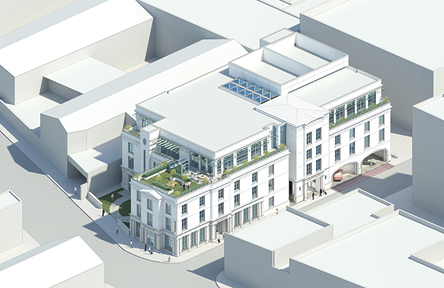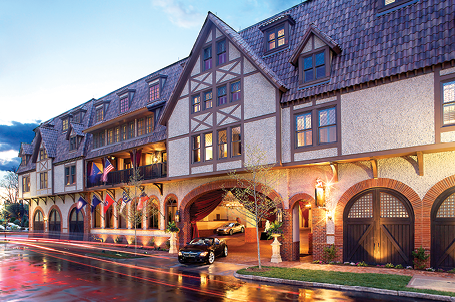- Home
- Media Kit
- Current Issue
- Past Issues
- Ad Specs-Submission
- Ad Print Settings
- Reprints (PDF)
- Photo Specifications (PDF)
- Contact Us

![]()
ONLINE

Hotels That
Tell a Story
Editors’ Note
Richard Kessler has been Chairman and CEO of The Kessler Enterprise, Inc. since 1984. He is also former Chairman, President, and Chief Executive Officer of Days Inn of America, Inc. and former Chairman of Lutheran Brotherhood. In 1984, he founded The Kessler Enterprise. Some of his projects include The Kessler Collection of themed hotels and resorts, the 500-acre Silverwood Plantation residential community, the 1,000-acre Georgia North International Industrial Park, and commercial land developments.
Company Brief
The Kessler Collection’s (kesslercollection.com) portfolio of passionately created and artistically inspired boutique hotels boast chic design, luxe accommodations, enriching ambiance, and intuitive service. When visiting properties in Alabama, Colorado, Georgia, Florida, New Mexico, North Carolina, or South Carolina, each hotel’s exquisite art, music, and cultural influences are very approachable. Kessler guests are bathed in redefined Bohemian luxury, from an 1888 historic hotel or a cutting-edge downtown landmark to a magical castle, an earthy Native American retreat, or a high design southern mansion and elite ski lodge. The Kessler Collection, which was the founding member of the Marriott Autograph Collection, was introduced with seven Autograph Collection branded hotels and now proudly represents 11.
Would you talk about your vision in building The Kessler Collection?
I came up with the idea of creating some boutique hotels in 1979. At that time, I was CEO and Chairman of Days Inn, but I wanted to create a totally different division of high-end boutique hotels that was separate from Days Inn.

A rendering of the Grand Bohemian Hotel Charleston
I went to Savannah, Georgia and bought the Coca-Cola bottling plant, part of which included a building from the 1700s. We built a boutique hotel there and it worked very well. We were running strong occupancies, rates were great, and it was profitable in the first year.
Then I went to Orlando and bought another site, which was across from the first phase of the Orlando Convention Center. We designed a boutique hotel in that spot, which also became very profitable. At that point, I knew I was onto something.
Since then, I have done a number of other things, but I have decided to once again focus on high-end boutique hotels. In 1995, I moved back to Orlando, Florida and created Grand Theme Hotels, because I was thinking of it thematically and wanted each hotel to have a unique storyline.
We went in focused on the idea of small, themed hotels, and slowly advanced the idea, moving the dial from high three-star/low four-star to high four-star.
The first themed property I opened was the Castle in Orlando. We just spent $6 million there to ready it to become an Autograph Collection property. It’s doing very well.
After that, I bought a property on SR 535 in Florida with the concept of creating an African theme hotel since I knew that Disney was developing its new Animal Kingdom®. I bought a Days Inn that we had previously owned and was planning on spending several million in remodeling when I was offered an enormous amount of money for it. The buyers then carried out my concept themselves and were very successful.
Immediately after that, I created the Grand Bohemian Hotel in downtown Orlando. This was the first of our high-end boutique hotels. From there, I bought the court house in St. Augustine and purchased a site from Disney in the town named Celebration where we created the Celebration Hotel, which is now named the Bohemian Hotel. Then we immediately started with a high four-star focus and it has remained that way ever since.

Grand Bohemian Hotel Asheville
What are the key ingredients that define a boutique property?
What really defines it is scale. A 400-room hotel cannot be made into a boutique property.
Generally, a true boutique hotel needs to have around 200 rooms or fewer. Even in the range of 250 rooms, which is what I put in at the Grand Bohemian Hotel, the property needs to be scaled down – we made the lobby very intimate and of very high quality with a beautiful bar next to it.
A boutique hotel also has to be unique – there cannot be a chain boutique hotel. Every hotel has to have it’s own personality, story, and theme. It also needs a high level of attention to detail.
Cuisine is another important element. I want our food to be even better than our hotels. We work hard to make that happen and, as a result, our food operations are both excellent and profitable.
We want guests who desire the uniqueness of a boutique hotel to stay with us and to be able to continue their unique experience through dining. We apply the hotel’s storyline to its restaurant, making the concept seamless, and guests feel it’s special as a result.
The last issue relates to the quality of the staff – we call our staff “Grand Performers.” The underlying theme at all of our hotels is art and music, which are my personal passions.
Is personality very important in appointing your staff?
Although every hotel needs employees who love people, in a boutique hotel, employees must be able to relate to guests in a warm and fuzzy way. People expect personalized attention at a boutique hotel and we strive to meet those expectations.
Is the focus of your properties more on the Kessler brand or on the brands of the individual hotels?
Each of our hotels has a different personality. However, guests recognize a high level of detail at all of the Kessler hotels. This distinction from other brands allows them to simultaneously experience the hotel’s personality and the Kessler mark.
Are opportunities for expansion hard to find?
The key is spending a significant amount of time thinking through our concept and analyzing what the story is that we want to tell, and if it’s appropriate for the location we’re in.
It takes a lot longer to do that than to design a box hotel. It’s important to spend a lot of time on the front end to understand the market and develop a concept that is not only marketable in that community but that also fits within our own brand concept around music and art.
Do you anticipate broadening into different areas of the country?
It is easier from a management and development point of view if we grow regionally. We’ve looked at doing some things in California and even had a couple of sites under contract. However, the difficulties and regulations were so burdensome, that we had to ask ourselves why we were doing it when the same quality of hotel could be done on the East Coast for a third of the effort.
At some point, I would like to do something in California but I don’t want to have to spend several years to get permits to build a property.
We’re focusing on the Eastern U.S. right now. We’re under construction in Charleston, South Carolina where we will open a 50-room, very-high-end boutique hotel in July. Thematically, it has a strong French influence, with a very unusual restaurant program, which is tied to the long-term history of the city. We’re also doing something very special with wine and wine blending that has never been done in the industry before.
In addition, we’re opening a 100-room property in Mountain Brook, Alabama, which is part of the Birmingham area. We’re across from the botanical garden so we chose a floral theme, which we’re driving all the way through the hotel. It’s going to be a beautiful, southern hotel. We’re working with Southern Living magazine on the design of a few of the rooms in the hotel as well as our large garden and our smaller one. Working with Southern Living is linking us to the community and the region.
After that, we’re going back to Savannah to focus on the old Georgia power plant building that I purchased. Built in 1912, it is a very large, 200,000-square-foot building. It is the centerpiece of a mixed-use complex with five major buildings, three smaller buildings, and six kiosks. The 1912 building is six stories tall and has a steel frame. Inside, there is a 65-foot high and 400-foot long atrium.
The property is four acres with 1,100 feet on the Savannah River. We’re building a 500-car garage because there is very limited parking in the area. We’re wrapping two sides with hotel rooms facing the river. We’ll also have rooms on top of it with a swimming pool and beverage outlets so the parking won’t be as noticeable. On the ground level, there will be a 7,000-square-foot ballroom, which will also feature a 4,000-foot live entertainment center.
There will be a separate hotel on the river called The Three Muses. The rooms begin on the second floor, with a very artsy and romantic southern theme. On the ground level, we’re putting in restaurants and retail, and we’ll also have a kids’ museum in one building. We’ll have an ice-cream shop that will feature some new concepts, as well as a high-end Mexican restaurant and tequila bar called La Cava. We will be operating two restaurants ourselves: an English pub and a high-end pizza restaurant. We’ll have five bars located throughout the different buildings and two rooftop bars.

Master plan for the Power Plant in Savannah, Georgia
Is this project a departure for you or is it still considered boutique?
It’s still considered boutique because there are two hotels. The historic building has 177 rooms in it. Some of the group business will be hosted in this historic building.
Across from the arrival entrance, the parking deck is wrapped in 100 rooms. We think families are going to gravitate to this building because it has an open-top roof, a huge swimming pool, a bar, and a fitness center, as well as great views.
The second hotel, The Three Muses, is around 144 rooms, one six-story building, one four-story building, and one three-story building that are all connected with skywalks.
Can you still be as hands-on as you like to be with all of these projects?
Yes, I have already bought all of the art for it. For example, in the historic building in Savannah, my goal for the design is to tell the story of the history of power. We have huge fossils, amethysts, and citrine crystals which will all be used in the historic building. We also have petrified wood and semi-precious stone slabs, which will be placed in specific locations in the building.
We hired the company that works with Disney/Universal to create an industrial lightshow. One year ago, I contracted with a young man who writes music for the movie industry to create music for the lightshow. It’s fantastic.
When you have a vision, can you tell in advance whether it’s going to work?
I can already visualize what it’s going to look like, so it’s very easy for me to work with the design teams.
Are you a demanding person to work for?
At times, I’m very demanding when it comes to detail. My people have to be good listeners. I expect all of them to provide input and then look to the talented people around me to complete the design. Creative people work extremely well with me.•